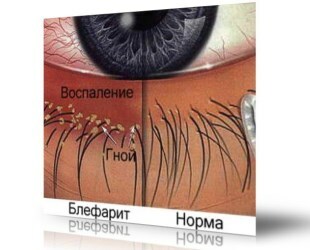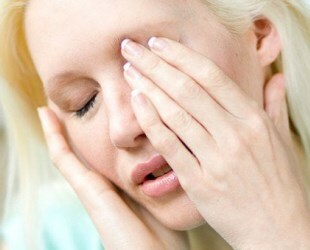
Blepharitis - a large number of various eye diseases that are characterized by chronic inflammatory processes on the eyelids and poorly treatable.
The disease lasts a long time, there is a high probability of relapse. Blepharitis greatly affects the quality of life, reducing its performance, and in rare cases even leads to loss of vision.
Causes of
- 1. Causes of
- 2. Symptoms of
- 3. Blepharitis varieties
- 4. Diagnosis of
- 5. Treatment of
- 6. How to prevent the development of the disease
The following factors are among the main causes of blepharitis:
- allergy and chroniceye infections;
- viral infection: demodectic, staphylococcus aureus;
- anemia, lack of vitamins in the body;
- diseases of the nasopharynx, caries;
- failure in the digestive tract;
- improper metabolism;
- myopia or hyperopia;
- conjunctivitis in chronic form, diseases of lacrimal ducts;
- low level of immunity;
- constant contact with wind, smoke and dust.
Symptoms of

The main symptoms of blepharitis include:
- sensation of itching in the eyes;
- thickening and a sense of heaviness in the eyelids;
- eye fatigue;
- sensitivity to bright light, various stimuli;
- edema and redness of the eyelids;
- white scales on the eyelids;
- partial baldness;
- loss of eyelashes, improper growth.
Types of blepharitis
There are several types of diseases:
- Simple or flaky blepharitis( seborrhea) .It is characterized by reddening and thickening of the eyelids, itching, narrowing of the eye gap, photophobia. At the base of the eyelashes, you can observe yellow or white scales, very similar to dandruff. The skin under the scales is red, sometimes you can see blood vessels. Eyelids strongly itch. The sensitivity to light is very high, and also the reaction to wind and dust is increased. In the evening, my eyes are very tired. If there is no treatment for a long time, blepharitis can last very long.
- Blepharitis ulcerative .The most severe form of the disease with severe pain develops most often at a young age. On the edges of the eyelids, not scales are formed, but crusts with bleeding sores. Together with the crusts, eyelashes fall off, and pus emanates from the hole. New eyelashes can grow in the wrong direction, there is baldness. In rare cases, scars develop on the eyelids, or the eyelid turns. Without proper treatment, the inflammatory process can move to the conjunctiva and the cornea.
- Mabemia blepharitis .Infecting meibomian glands, which are in the thickness of the cartilage of the eyelids. At pressing on them the yellowish liquid is allocated. In the corners of the eyes you can observe purulent discharge. The disease can occur in conjunction with conjunctivitis. Demodectic blepharitis .The reason is demodex mite, which lives in ciliated bulbs. He is present in every person and declares himself in favorable conditions for himself, for example, with a decrease in immunity. Symptoms of the variety are severe itching, especially after sleep. There are discharge from the eyes, I want to scratch my eyes. Gradually, the eyelids thicken, becoming red. At the base of the eyelashes appear white flakes, similar to a collar or collar.
- Blepharitis allergic to .Often combined with conjunctivitis. The reason - the increased sensitivity to any medicinal products, products of cosmetology or perfumes. Also, an allergic reaction appears due to contact with pollen, dust, hair, fluff, household chemicals. Suddenly, the eyelids swell, tears flow, eyes are cut, eyelids itch and it is painful to look at the light. Most often, both eyes are affected. The chronic form is characterized by an intolerable pruritus of the eyelids. Aggravations most often occur during flowering.
Based on anatomical signs, the following types of blepharitis are distinguished:
- anterior edge - only the area of eyelash growth is affected;
- posterior marginal - inflammation of the meibomian glands, resulting in inflammation of the cornea and conjunctiva;
- angular - inflammation of the corners of the eyes with the accumulation of purulent secretions in them and thickening of the eyelids, the appearance of ulcers.
Diagnostics

The diagnosis of the disease is based on a visual examination of eyelashes and eyelids with a slit lamp. Sometimes a laboratory examination is made for the cellular or microbial composition of the scrap taken from the conjunctiva and determine the presence of microscopic demodex ticks to the bulb of the eyelashes.
Treatment of
If there is a suspicion of blepharitis, it is better to contact the ophthalmologist or therapist sooner. The latter should be visited to exclude systemic disease of the body or visual impairment.
Treatment depends on the variety of the disease and the underlying cause, but the common traditional methods are the use of:
- ointment eye hydrocortisone;
- erythromycin and tetracycline ointments;
- Blepharogel;
- Miramistin;
- antibacterial eye drops;
- drops anti-inflammatory( Tevodex, Gentamicin, Albucid, Maxitrol, Ofloxacin).
The path to recovery can last several months, and this is subject to the full range of treatment and hygiene measures. It is very important to strengthen immunity. In some cases, an effective method of treatment is eyelid massage, which can only be done if the doctor permits.
In rare and neglected cases, complications may occur: eyelid twisting or scarring. In such cases, surgery or eyelid plastic surgery is not excluded.
How to prevent the development of the disease
For prevention, a person should adhere to the following measures:
- maintain and strengthen immunity;
- to eat fully;
- treat diseases that can cause blepharitis;
- observe the necessary rules of personal hygiene( have your own individual towels, cosmetics, soap and others);
- keep the house clean and at work. Read more - heterochromia of the eyes. What is this disease and how to treat it?
In the news( link) the inner structure of the human eye.
Treatment of astigmatism of the eye!http: //moezrenie.com/bolezni/ narusheniya-refraktsii / astigmatizm-glaz.html
Regardless of what could trigger the development of the disease, a person must:
- comply with the milk-vegetable diet;
- meat products only eat boiled;
- can not eat pickled, salty, sharp and sweet foods;
- to pass a stool test to rule out helminthic invasion;
- not to allow constipation, and in their case, should take laxatives;
- try not to get sick with colds, ARVI, flu;
- should be started every morning with hygienic procedures;
- wash eyelids followed by warm water, but not cold;
- after washing, massage the eyelids;
- before the massage, it is desirable to inject into the eyes 2% solution of novocaine to relieve the unpleasant sensations;
- after the massage is wiped with a mixture of alcohol and ether, and then drops are added to the eyes;
- flakes on eyelashes can be dipped with furatsilinom;
- TV can be watched no more than 1-2 hours;
- sleep at least 8 hours a day.
Article helped? Perhaps it will help your friends! Please click on one of the buttons:
